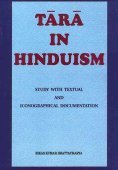Vaidiki, Vaidikī: 4 definitions
Introduction:
Vaidiki means something in Hinduism, Sanskrit, Marathi. If you want to know the exact meaning, history, etymology or English translation of this term then check out the descriptions on this page. Add your comment or reference to a book if you want to contribute to this summary article.
In Hinduism
Shaivism (Shaiva philosophy)
Source: Brill: Śaivism and the Tantric TraditionsVaidikī (वैदिकी) refers to “Vedic rules”, according to Tantrālokaviveka commentary on the Tantrāloka verses 4.230ab-232ab.—Accordingly, “[‘If you argue that this Śaiva rule is invalidated by the Vedic one (vaidikī), (we reply:) why shouldn’t it be the other way around?’].—[...] Considering that one may object by asking how it is that both [śāstras] are equally real, given that in certain contexts the injunction(s) associated with purity and the like are invalidated, even though they apply universally, for all people, [Abhinavagupta] says: [‘If you think about it clearly, a rule that is an exception invalidates a rule generally applied, because it applies in a particular domain’]. [...]”.

Shaiva (शैव, śaiva) or Shaivism (śaivism) represents a tradition of Hinduism worshiping Shiva as the supreme being. Closely related to Shaktism, Shaiva literature includes a range of scriptures, including Tantras, while the root of this tradition may be traced back to the ancient Vedas.
Languages of India and abroad
Marathi-English dictionary
Source: DDSA: The Molesworth Marathi and English Dictionaryvaidikī (वैदिकी).—a (vadika) Relating to a vaidika or Vedaprofessor--a practice, a rite.
--- OR ---
vaidikī (वैदिकी).—f The profession or the practice of a vaidika.
Source: DDSA: The Aryabhusan school dictionary, Marathi-Englishvaidikī (वैदिकी).—f The profession or practice of a vaidika.
Marathi is an Indo-European language having over 70 million native speakers people in (predominantly) Maharashtra India. Marathi, like many other Indo-Aryan languages, evolved from early forms of Prakrit, which itself is a subset of Sanskrit, one of the most ancient languages of the world.
Nepali dictionary
Source: unoes: Nepali-English DictionaryVaidikī (वैदिकी):—adj. relating to or conformable to the Veda: characterizing the orthodox (as conduct);
Nepali is the primary language of the Nepalese people counting almost 20 million native speakers. The country of Nepal is situated in the Himalaya mountain range to the north of India.
See also (Relevant definitions)
Starts with: Vaidiki prakriya, Vaidikiprakriya, Vaidikishruti.
Query error!
Full-text: Vaidiki prakriya, Vaidika, Vaidik, Murari, Yupa, Kashyadi, Siddhantakaumudi, Ashtadhyayi, Avishishta, Sarvapurusha, Shuddhividhi, Vishishta, Tantrika, Vyakarana, Uddhara, Vaiyakaranasiddhantakaimudi, Iti, Apsaras, Shruti.
Relevant text
Search found 24 books and stories containing Vaidiki, Vaidikī; (plurals include: Vaidikis, Vaidikīs). You can also click to the full overview containing English textual excerpts. Below are direct links for the most relevant articles:
Notices of Sanskrit Manuscripts (by Rajendralala Mitra)
Skanda Purana (by G. V. Tagare)
Chapter 7 - Mode of Life in Mahākālavana < [Section 1 - Avantīkṣetra-māhātmya]
Chapter 107 - Procedure of the Worship of Brahmā < [Section 1 - Prabhāsa-kṣetra-māhātmya]
Garga Samhita (English) (by Danavir Goswami)
Verse 4.19.103 < [Chapter 19 - A Thousand Names of Srī Yamunā]
Bhakti-rasamrta-sindhu (by Śrīla Rūpa Gosvāmī)
Verse 1.2.200 < [Part 2 - Devotional Service in Practice (sādhana-bhakti)]
Taittiriya Upanishad Bhashya Vartika (by R. Balasubramanian)
Verse 2.29 < [Book 2 - Brahmavallī]
Vedic influence on the Sun-worship in the Puranas (by Goswami Mitali)
Part 9 - Non-Vedic Elements in the Purāṇic Religion < [Chapter 3 - General Characteristics of the Purāṇic Religion and its Link with the Vedic Tradition]
Part 7 - Religion of the Purāṇas < [Chapter 3 - General Characteristics of the Purāṇic Religion and its Link with the Vedic Tradition]
Related products
